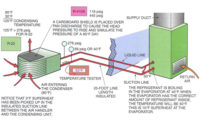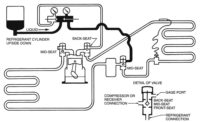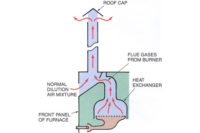The dispatcher asks Bob to call one of their company's good customers who wanted to talk to Bob in person about his system.
Bob calls the customer and the customer explains that he is having a very important business event at his home on Saturday night and that he wants to be sure that his air conditioners were operating correctly. He asks Bob to be in attendance to watch over the equipment during the event. The units are high-efficiency heat pumps, but they are about 10 years old. Bob is very familiar with the job. The customer explains that the entire house and party rooms must be comfortable, at about 72 degrees F. There are two 5-ton heat pumps and one 3-ton heat pump that serves the party room where people will have a tendency to gather. All of the air handlers and outdoor units are in remote places where Bob will not be noticed.

The equipment for this large home is:
Thermometer readings before the event starts:
Bob sits back with a soda and thinks, this is going to be some real easy overtime for hanging out and watching equipment on a Saturday night. He didn't know that he was about to earn his pay.
People begin to arrive and the temperature outside begins to drop. Then, the downstairs portion of the house is full of people and things begin to change. The readings go to:
Units 1 and 3 are losing ground it seems. Bob is getting concerned because the leaving air temperature is rising, like the units are losing capacity. Bob is scratching his head and starts for his truck to get a set of gauges when Btu Buddy appears and asks, "What is the problem, Bob?"
Bob shows him the readings and says, "The temperature is going up. I have to do something fast. They are depending on me and the equipment is losing ground."
Btu Buddy begins to ask questions, "What type of metering devices are on the units?"
Bob answers, "Unit 1 is a thermostatic expansion valve (TXV), Unit 2 is a TXV, and Unit 3 is a fixed bore orifice. What difference does it make?"
Btu Buddy then asks some more questions, "What is the outside temperature?"
Bob puts a temperature lead outside and it reads 60 degrees F.
Btu Buddy says, "Let's take one unit at a time. Unit 3 is where the real party is going on. The temperature inside is 74 degrees F and the outside temperature is 60 degrees F. Does something seem different to you about this?"
Bob says, "The temperature outside is cooler than the temperature inside."
Btu Buddy says, "Yes, that is true. What happens to condenser efficiency when the condenser is operating under cool conditions like this?"
Bob says, "It will become very efficient."
Btu Buddy then says, "Have you ever thought that it would become so efficient that the head pressure would drop so low that it would not push enough refrigerant through that orifice?"
Bob says, "No, I would have never thought of that."
Btu Buddy says, "Feel the suction line and tell me what you think."
Bob feels the suction line and says, "It is not cold. It feels like a low charge."
Btu Buddy then says, "Let's block some of the air going across that condenser and see what happens."
Bob gets a plastic garbage bag and wraps it part way around the condenser. Btu Buddy says, "Stand here for a few minutes until the air coming out of the condenser feels warm compared to your hand. Your hand temperature should be about 91 degrees F. If the air is slightly warmer than your hand, you will know that heat is really coming out of the condenser. The air was not warm at all when we first walked out here."
Bob asks, "Is there a chance that I can overload the system like this?"
Btu Buddy says, "Also feel the liquid line and let it get just warm to the touch, then you will know that the head pressure is rising but is not too high if the liquid line is just warmer than your hand. Let's go in and look at the temperatures now. As you know, I do not like to use gauges unless it is necessary because I have seen the charge altered using gauges and I have also seen too many technicians leave behind leaks using gauges when it was not necessary. Gauges should only be used when needed."
Btu Buddy says, "Now feel the suction line and describe it to me."

They go back inside and the Unit 1 readings are 74 degrees in and 55 degrees out.
Bob says, "Boy, what a difference that made. I still don't understand what happened. But before you answer, let's go do the same thing to Unit 3 and get the party room cooling down."
While they are putting plastic around the condenser to Unit 3, Btu Buddy says, "Unit 1 is cooling correctly at this time. It has a limited charge, meaning that during the cooling cycle, there should be a certain amount of refrigerant in the evaporator (the indoor coil) and a certain amount of refrigerant in the condenser (the outdoor coil). You do remember that from school don't you? Even though this unit has a TXV, it does not have a large receiver to hold extra refrigerant like some of the older units did."
Bob says, "Yes, the unit charge is correct."
Btu Buddy says, "The charge is correct for a design day which is, for example, 75 degrees F and 50 percent humidity return air entering the evaporator and 95 degrees F outside air entering the condenser. At that time, there will be a certain amount of refrigerant in the evaporator and the condenser. With the outdoor temperature at 60 degrees F, the condenser will become overly efficient and liquid refrigerant will back up in the condenser. Where do you think it will come from?"
Bob says, "The only place would be the evaporator."
"Correct," says Btu Buddy. "Now if there is more refrigerant in the condenser and it came from the evaporator, the evaporator must be starved for refrigerant."
Bob then says, "I see what you mean. If it is starved, it will lose capacity. And this system is losing capacity just when it really needs it. The only way to get it working is to raise the head pressure and push that refrigerant through the metering device to the evaporator where it can do its work."
Btu Buddy says, "Now you have the picture. It was a simple fix, but if you were not here to operate the equipment, most likely the owner would have kept turning the thermostat down and eventually gone to bed later at night without turning it back up. At the same time the space temperature would have been uncomfortable. You earned your pay tonight."
Bob then says, "But you have to know what to do to operate equipment out of its design parameters. You made the difference. I will never forget this night."
They go back inside and look at the temperatures, and Unit 1's air temperatures are 73 degrees in and 53 degrees out. Unit 3's temperatures are 73 degrees in and 53 degrees out.
Bob says, "This is really great. The units are gaining on the load now. You never did answer the question about the TXV versus the orifice expansion device."
Btu Buddy explains, "Both the orifice and the TXV metering device have a critical charge in a heat pump system. The TXV is much more forgiving than the orifice. The orifice will starve the coil much faster than the TXV, but neither one of them will operate well under the conditions that this job demanded."
Bob responds, "This has been a real learning experience and you have been a real help."
At the end of the night the owner comes out to talk to Bob and says, "Bob, you must have done a good job, because the conditions were just great in the house for the whole event. Thanks."
As Bob is riding away, Btu Buddy says, "Bob, that was a job that was well done. You have a very satisfied customer and they are not easy to get."
Bill Johnson has been active in the HVACR industry since the 1950s. He graduated in gas fuel technology and refrigeration from the Southern Technical Institute, a branch of Georgia Tech (now known as Southern Polytechnic Institute). He taught HVAC classes at Coosa Valley Vocational & Technical Institute for four years. He moved on to become service manager for Layne Trane, Charlotte, N.C. He taught for 15 years at Central Piedmont Community College, part of this time as program director. He had his own business for five years doing installation and service work. Now retired, he is the author of Practical Heating Technology and Practical Cooling Technology, and continues as a co-author of Refrigeration & Air Conditioning Technology, 5th Edition, all published by Thomson Delmar Learning. For more information, he can be reached at 704-553-0087, 704-643-3928 (fax), or billj@carolina.rr.com.
Publication date: 03/20/2006







